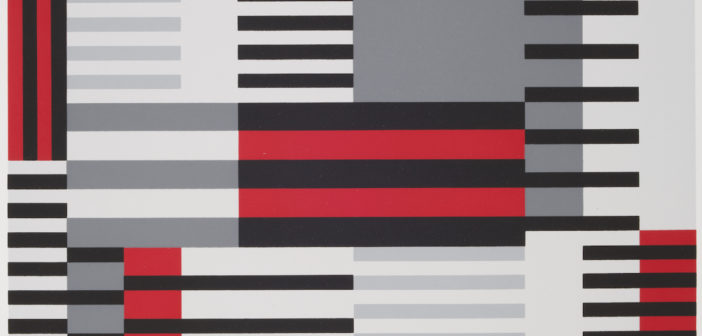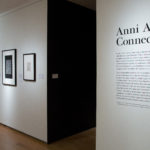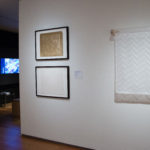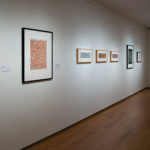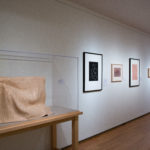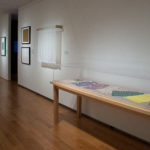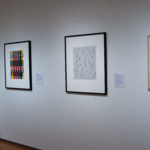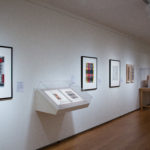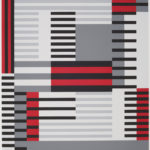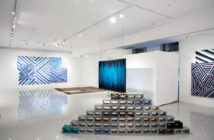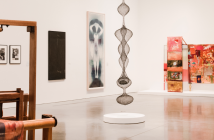In 1984, ten years before her death, Anni Albers published Connections—a culmination, or perhaps a synthesis, of her aesthetic worldview as captured in nine silkscreens. A recent acquisition of the Davis Museum at Wellesley College, the silkscreen portfolio, reflecting nearly six decades of artistic exploration, inspired the exhibition “Anni Albers: Connections” now on view at the Davis (through Dec. 18). Located in the lower level Marjorie and Gerald Bronfman Gallery, a modest rectangular space, the exhibition is at once spare, logical and layered.
Pivotal periods in Albers’s career are represented in “Connections,” the nine silkscreens spanning her evolution as an artist, from early textiles and weavings to later prints. Curator Claire Whitner organized the exhibition with accompanying works by Albers that help frame the silkscreens: preparatory sketches, fabric swatches, gouache maquettes, and commercially manufactured textile remnants. Throughout her work we see Albers playing with the Bauhaus ideal that function can be driven by design and that elements of design can become art.
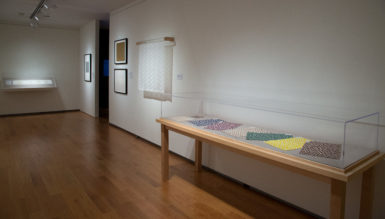
“Anni Albers: Connections,” installation view. Photo Credit: Steve Briggs. Courtesy Davis Museum at Wellesley College.
Annelise (Anni) Fleischmann enrolled at the Bauhaus, in Germany, in 1922. The school was divided along gender lines: women studied bookbinding, pottery or textiles. Despite her initial lack of interest in textiles, Anni found her voice here and proved that this so-called “soft” art was as compelling a medium as painting or sculpture, and rife for intellectual exploration. She also met and married Josef Albers, and the two supported and worked alongside one another for decades, relocating to the United States in the 1940s to flee Nazi Germany and to teach at the experimental Black Mountain College in North Carolina.
The fact that Albers would summarize her own work as a work of art itself is a testament to her brilliance and resolve: she worked as a woman in a man’s world from her earliest days at the Bauhaus to her later years in the U.S. She helped further the idea that art, both regarding its design elements and aesthetic beauty, could inform society, taking art from its silo. As a movement, Bauhaus-inspired modernism was often criticized for the very thing it hoped to rectify, the perception that manufacturing was, by definition, a soulless enterprise. Albers sought to prove otherwise.
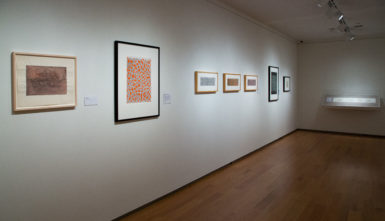
“Anni Albers: Connections,” installation view. Photo Credit: Steve Briggs. Courtesy Davis Museum at Wellesley College.
For instance, the simplicity of “Untitled 1948” (from the Connections portfolio) suggests more than one meaning: a single line threads across a black visual field so that the eye is drawn in at one end, following it to its exit. The viewer is engaged—the image, although two-dimensional, is not static. This simple image, a departure from weaving, abstracts a single fiber’s trajectory, giving meaning to its form outside of function. What can be gleaned from this image? It is spare, and it is lovely to behold in its simplicity—it is removed from its function and yet honors functionality.
Exploring the idea further, the gouache maquette “Drawing for a Rug II,” (1959) elucidates the abstraction of line into image. Two-dimensional “fibers” snake harmoniously across the rectangular field, the spaces between them popping with color: royal blue, brilliant orange, scarlet red, even ochre, and mustard.
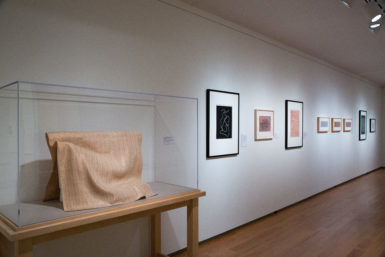
“Anni Albers: Connections,” installation view. Photo Credit: Steve Briggs. Courtesy Davis Museum at Wellesley College.
If one could describe these works in a phrase—both the nine silkscreen images and their supporting counterparts—it would be elegant containment or controlled chaos. Albers’s visual sensibility is rich with possibility: from golden-thread textiles meant to be functional to weavings intended to be hung, enjoyed simply as visual art. As an artist she never wavered from abstract ideals: exploring the notion that, even if devoid of representation, deceptively simple constructs allow for infinite aesthetic possibilities. Texture, flow, design, harmony—Albers’s contributions are lasting and profound.
- “Anni Albers: Connections,” Installation view. Photo Credit: Steve Briggs. Courtesy the Davis Museum at Wellesley College.
- “Anni Albers: Connections,” Installation view. Photo Credit: Steve Briggs. Courtesy the Davis Museum at Wellesley College.
- “Anni Albers: Connections,” Installation view. Photo Credit: Steve Briggs. Courtesy the Davis Museum at Wellesley College.
- “Anni Albers: Connections,” Installation view. Photo Credit: Steve Briggs. Courtesy the Davis Museum at Wellesley College.
- “Anni Albers: Connections,” Installation view. Photo Credit: Steve Briggs. Courtesy the Davis Museum at Wellesley College.
- “Anni Albers: Connections,” Installation view. Photo Credit: Steve Briggs. Courtesy the Davis Museum at Wellesley College.
- “Anni Albers: Connections,” Installation view. Photo Credit: Steve Briggs. Courtesy the Davis Museum at Wellesley College.
- Anni Albers, “Smyrna-knüpfteppich (Bauhaus-period), from the portfolio “Connections/1925/1983”, 1925 Screen print, image: 20 1/8 in. x 15 1/8 in. (51.1 cm x 38.4 cm); sheet: 27 1/2 in. x 19 11/16 in. (69.8 cm x 50 cm) Museum purchase, The Nancy Gray Sherrill, Class of 1954, Collection Acquisition Fund 2016.6.2
Anni Albers: Connections is on view at the Davis Museum at Wellesley College through December 18.

